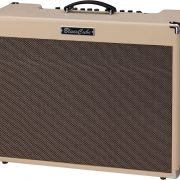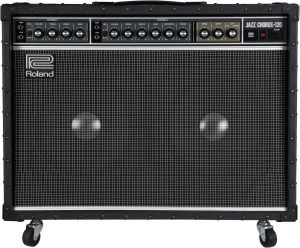Guitar amplifiers are unique in the world of music. Generally, an electronic audio amplifier will be a device that makes a source signal louder. Electric guitar amplifiers however, are capable of so much more.
Guitar amplifiers imprint their own sonic signatures onto a player’s sound and significantly alter the way that the guitar actually feels under the player’s fingers. Without a doubt, the guitar amplifier is an integral part of the instrument itself.
As such, it is part of an electric guitar player’s journey to find an amplifier for them and their chosen guitar. In this endeavour, knowledge is imperative. The more a guitarist understands about how a guitar amplifier functions, the better equipped they are to achieve their own unique tone.
In this article, we’ll break down a guitar amplifier into its functional parts and explain how each of these parts work. We’ll also look at how these parts interact with each other to create guitar tone.
Contributed by Matt Walsham for the Roland Australia Blog
Anatomy of a basic guitar amplifier
At the most fundamental level, a guitar amplifier consists of three sections. These are:
- The preamp
- The power amp
- The speaker
This diagram represents the basic internal architecture of guitar amplifiers from the 1930’s until the mid-1970’s.

1) The preamp contains the circuitry that is primarily responsible for shaping the guitar sound and delivering it to the power amp in an optimal form. Almost all of the controls on the front panel of the guitar amp (gain, bass, mid, treble, volume etc.) are controlling the circuitry within the preamp.
2) The power amp receives the signal from the preamp. It then outputs a much larger version of the signal with voltage high enough to drive a speaker.
3) The speaker is a transducer system that turns electrical energy (from the power amp) into audible sound.
 Guitar amplifiers built with the preamp, power amp and speaker all in the same wooden box are called combo amplifiers. Combo amplifiers are the most popular style of guitar amplifier, due to their convenience and portability.
Guitar amplifiers built with the preamp, power amp and speaker all in the same wooden box are called combo amplifiers. Combo amplifiers are the most popular style of guitar amplifier, due to their convenience and portability.
Some players require bigger, high-powered amplifiers with multiple speakers to fill large venues, as multiple combo amplifiers become too unwieldy to carry.
 These amplifiers separate into two physical boxes. One box contains the preamp and power amp sections (called the amplifier head) and another box contains only the speakers (called the speaker cabinet).
These amplifiers separate into two physical boxes. One box contains the preamp and power amp sections (called the amplifier head) and another box contains only the speakers (called the speaker cabinet).
This setup is an amp stack or simply, a stack. A stack with one head and two speaker cabinets is a full stack. A single head paired with a single speaker cabinet is a half stack.
At the most fundamental level, every guitar amplifier features a preamp, power amp and speaker. Let’s now discuss the function of each of these components in more depth.
The Preamp
The electrical signal generated from a guitar’s magnetic pickups has a tiny voltage, small current and is very susceptible to degradation and interference. The main task of the preamp is to transform and shape this tiny signal (the input signal) into a larger, stronger signal for more effective use.
The preamp does this is by passing the input signal through circuitry called gain stages, usually at least 2. The main component of a gain stage is an active electronic component, either a vacuum tube or a transistor.
This component amplifies the miniscule input signal to a larger size and converts it to a much lower impedance. Now larger and more robust, the signal can pass through the rest of the amp’s circuit more freely.
It’s important to note that the increased input signal is still relatively small and requires more amplification further down the circuit.
A preamp also normally contains some simple noise filtering circuits. These remove electromagnetic interferences that attack the input signal on its way down the guitar cable and into the amplifier.
The simplest preamp takes a single gain stage, feeds it into a volume control and outputs it to a power amp. However, the first guitar amp engineers quickly realised that the preamp is the ideal place to add a tone control network.
Tone controls allow the player to shape their guitar sound using knobs on the amp’s front panel. This tone control network (sometimes called a tone stack or equaliser/EQ) is where a large part of a guitar amp’s individual tone comes from.
The majority of guitar amps still use the basic TREBLE/MIDDLE/BASS tone control layout first seen in the tweed amps of the 1950’s. Roland’s own Blues Cube line-up pays homage to these fabulous guitar amplifiers by tweaking their modern preamp design to behave in precisely the same manner as a late 50’s tweed amplifier.
Modern guitar amps have the capability to generate a lot of overdrive and distortion at low volume levels. They also have different channels to switch between clean and overdriven sounds. Some modern guitar amplifiers contain on-board digital effects. The preamp section holds all of this technology.

Through tone shaping, generating overdrive and adding effects, the preamp is one of the key factors of what makes guitar amplifiers sound different each another. It is the heart of the amp’s tonal character and response.
When the preamp has shaped the guitar’s input signal, it sends the signal on to the power amp.
Power Amp
After increasing and passing through the pre-amplification stage, the guitar input signal strength is still relatively small. Now certainly more usable, it is not yet potent enough to drive a large speaker.
The function of the power amp is to output an electrical signal with the exact same waveform as the input signal. Boosted to a much higher voltage via power from the mains wall socket, the signal now becomes more usable. In simpler terms, the power amp takes the input signal and makes it much stronger.
Just like the preamp gain stages discussed earlier, the signal amplification uses transistors or vacuum tubes. These devices are physically larger than in the preamp section, due to the much higher voltages they use.
Transistors and tubes both perform similar tasks. Having originated in the early 20th century, vacuum tubes are an older technology. Their designs have endured until the present day because of certain pleasing audio artefacts that their operational imperfections create.
Solid-State devices (or transistors) allow designers to create very small and lightweight designs. At lower volumes, solid-state guitar amplifiers maintain sounds also reached at much louder levels. This has obvious advantages, the main one being they don’t need high volume to sound great!
 Prominent solid-state guitar amplifiers are the early 1980’s Roland SIP-300 preamp and the Roland JC-120 Jazz Chorus. The JC-120, produced from 1975 until today is the benchmark in clean guitar sound.
Prominent solid-state guitar amplifiers are the early 1980’s Roland SIP-300 preamp and the Roland JC-120 Jazz Chorus. The JC-120, produced from 1975 until today is the benchmark in clean guitar sound.
Recent developments in technology now make it possible to carefully measure, record and understand the relationship between tubes, output transformers and speakers in a tube amp. All of these things combine to create a pleasant playing experience.
During development of the Roland Blues Cube series of guitar amplifiers, our designers painstakingly identified the complex interactions between every single component inside the power amp section of a vintage, all-tube, tweed amplifier. They completely replicated this complex behaviour and the playing experience within the solid-state, lightweight power amp of the Blues Cube.
The Speaker and the Speaker Cabinet
Now that the power amp has generated a high voltage facsimile of the input signal, it is powerful enough to drive the final component of the guitar amp. This is the Speaker.
The speaker is an electronic transducer. It receives electrical energy and converts it into sound. As the part of the guitar amplifier that actually creates the amplifier’s sound, it is a hugely important (and often overlooked) link in the chain towards creating a great guitar tone.
The size of the speaker in a guitar amplifier varies depending on its purpose. Practice amps, designed for use at home, have small speakers from 4” to 8” in diameter. The majority of professional guitar amplifiers have 12” speakers as they have a frequency range that suits the guitar sound at stage volumes.
As with any speaker system, the design of the speaker cabinet is a huge factor in how the speaker performs and ultimately sounds. A larger speaker cabinet with greater internal volume will allow for more low midrange and bass frequencies to develop and deliver a full-bodied sound. Smaller speaker cabinets lend themselves to more midrange-focused tones.
 Another significant factor in the tone of a guitar amplifier is the speaker cabinet construction style. Most combo amps are of an open back construction, where a portion of the amplifier’s back panel is not present. The speakers are visible.
Another significant factor in the tone of a guitar amplifier is the speaker cabinet construction style. Most combo amps are of an open back construction, where a portion of the amplifier’s back panel is not present. The speakers are visible.
This provides benefits in keeping the amplifier from overheating and also lends certain audio characteristics to the amp.
Open-backed speaker cabinets increase the sound dispersion into a room. The amp sound is spread evenly in different locations, but limits bass response.
A closed-back speaker cabinet will generate bass, though the sound will be directional. This creates significant audibility loss if the listener steps to the left or right of the speaker cabinet.
Recap
Through this article, we have learned how a guitar amplifier operates. We have also identified its main building blocks.
From the guitar’s pickup, the input signal enters the amplifier at the preamp. The preamp boosts the signal and removes any interference noise. It then shapes the tone via the 3-band EQ. Processed by the preamp, the signal passes along to the power amp.
The power amp uses power from the AC mains outlet to create a high power replica of the input signal. This high power signal hits the speaker, which transforms the voltage into sound waves. The design of the speaker cabinet shapes and distributes the sound waves.
This article describes the behaviour of every guitar amplifier. In Inside a Guitar Amplifier Part 2, we’ll take an even more in-depth look at various amp features such as multi-channel amps, master volume controls, effects loops and more. Stay tuned!
RELATED ARTICLES




